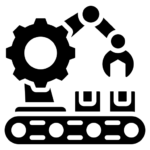TLDR: On-demand app development is a strategic necessity, driving the on-demand economy toward an estimated $335 billion. These mobile and web applications act as a digital intermediary for services like delivery, rentals, and ride-hailing, offering immediate, tailored customer experiences.The apps provide real-time service delivery, scalability, and data-driven insights, which are critical for gaining a competitive edge and boosting revenue
By 2025, the development of on-demand apps is not just than a trend; it is a strategic necessity for companies hoping to provide immediate, tailored services. No matter if you are a startup founder or a veteran CEO, the creation of an on-demand service application has potential value in providing new income, increasing customer satisfaction, and preparing your future business for continued success.
Whether it’s on-demand Uber app development design or multi-purpose platforms to provide on-demand services, the ongoing capability in real-time is transforming the industry.
What is On-Demand Application Development?
On-demand app development involves the development of mobile and web applications that allow users to request goods or services in-person or digitally and, in some instances, find goods or services wherever they are located. In essence, these applications serve as the digital intermediary between the service provider and the client. Examples of goods and services to request on-demand apps include food delivery, transportation, lodging, etc. These apps provide consumer-facing features, including real-time requests through chat, booking, tracking, and monitoring, secure payment avenues, etc., and in-app preferences.
According to PwC, the entire on-demand economy will reach $335 billion at the end of this year, driven by consumers’ need for speed, convenience, and mobile-first solutions.
Types of On-Demand Service Apps
1. On-Demand Service App Development
Apps that connect users with professionals for services like plumbing, beauty, tutoring, or home cleaning.
- Examples: Urban Company, TaskRabbit
2. On-Demand Delivery Apps
Enable users to order groceries, meals, or packages for quick delivery.
- Examples: Zomato, Instamart
3. On-Demand Rental Platforms
Allow users to rent vehicles, properties, or equipment.
- Examples: Airbnb, Zoomcar
4. On-Demand Marketplace Apps
Aggregate multiple vendors under one platform for diverse services.
- Examples: Amazon, Flipkart
5. On-Demand Uber App Development
Specialized apps for ride-hailing and transportation services.
- Examples: Uber, Lyft
Popular Technologies & Tools for On-Demand App Development
To build a strong and scalable app, developers use:
- Frontend: React Native, Flutter, Swift, Kotlin
- Backend: Node.js, Ruby on Rails, Django
- Cloud Services: AWS, Google Cloud, Azure
- Payment Integration: Stripe, Razorpay, PayPal
- Messaging & Notifications: Firebase, Twilio
- Geolocation: Google Maps API
These tools ensure seamless performance, real-time tracking, and secure transactions critical for successful on-demand application development.
Advantages of On-Demand App Development Services
- Service Delivery in Real Time: Fulfill the customer’s need right away
- Scalability: Grow over locations and services
- Offers Data-Driven Insight: Understand user habits and improve services
- Cost-Effective: Lower manual processes and expenses
Why Do Businesses Need On-Demand Service App Development
There are several reasons why a business needs On-Demand Service App Development. Some of the reasons are discussed below:
- Consumer Expectations
Speed and convenience are must-have features - Competitive Edge
Differentiate yourself with tech-enhanced service - Operational Efficiency
Make reservations, transactions, and customer support automatic - Revenue Growth
Collect money from subscriptions, ads, and exclusive features.
On-Demand Apps vs Traditional Web Portals
| Feature | On-Demand App | Traditional Web Portal |
| Real-Time Booking | Yes | Limited |
| Mobile Accessibility | Optimized | Often desktop-first |
| Push Notifications | Built-in | Requires email or SMS |
| Geolocation & Tracking | Live tracking | Not integrated |
| Personalization | AI-driven | Basic filtering |
Case Studies
Organic Grocery Delivery Startup: Boosting Customer Retention with Intelligent On-Demand Technology
A startup focusing on organic grocery delivery faced a roadblock, which many startups in this crossroads phase experience – managing customer demand, but staying personal and authentic in their service. The customer journey map they used onsite had orders tracked manually, there wasn’t visibility in to their customer relationship management system, and inventory updates were not real-time to keep up with demand.
The company engaged a custom technology solution that developed an on-demand application platform to create an integrated ecosystem that connected customers, delivery partners, and inventory systems in real-time.
Key Features:
- Real-Time Inventory Management System: Customers saw only in-stock merchandize with a miniscule amount of cancelled orders which reduced the uncertainty of the experience for all parties involved.
- CRM Integration: Personalized offers and loyalty rewards were automatically pushed to frequent customers in the system.
- Smart Billing System: Automated invoicing, subscription billing, and digital receipts streamlined finance operations.
- Customer Insights Dashboard of Advanced Analytics: Helped track buying behavior to inform promotion and pricing strategy in the near term.
Impact:
- 25% increase in repeat customers within three months.
- 40% less manual admin work is done each week to free the team to focus on trying to grow the business instead of just managing it.
- Improved operational transparency, customer satisfaction, and delivery accuracy.
Ride-Hailing Platform: Making Hotel Guest Transportation Effortless
An international ride-hailing company partnered with a large hotel chain to facilitate faster, smoother ride bookings for guests and employees.
Previously, hotel guests were dependent on front-desk staff to book rides manually, leading to delays and confusion.
- Guests can book rides instantly through a hotel-branded app or lobby tablet.
- Staff will manage and track multiple ride requests in real time.
- Integrated APIs to show live driver availability, fares, and payment options.
Results:
- 40% faster ride-booking times.
- More completed rides from hotel locations.
- Improved guest satisfaction and smoother hotel operations.
Conclusion
On-demand app development is transforming how businesses operate and interact with their customers. Whether it’s a taxi booking tool, a home service app, or a multi-service marketplace, the investment in on-demand app development is an investment in the future into 2025 and beyond.
At WildnetEdge, we provide an extensive range of on-demand app development services that cover everything from MVPs to fully developed platforms. Our expertise in on-demand app development can help you bring your vision to life while maximizing your chances of success.
FAQs
Q1: How do you create an on-demand application?
Creating an on-demand application requires connecting a number of your selection apps to a template on-demand application. Selection apps and template apps are the two ingredients for an on-demand application. So, you’ll first need these two apps that can connect together, in order to create an on-demand application.
Q2: How much should you expect to pay for on-demand application development?
While the costs associated with on-demand application development can range from approximately 10 to 80k, these are not definitive costs. Costs can vary depending on many factors, such as what features or functionality will be available in native versus hybrid app development, developer location, and complexity of development.
Q3: What industries benefit most from on-demand apps?
Healthcare, logistics, food delivery, home services, and transportation are the most benefitted from on-demand application development.
Q4: What are the best on-demand platforms?
Familiar On-demand app service options:
- Netflix:
It was the pioneer company to employ the subscription model for streaming. - YouTube Premium:
It offers ad-free access, along with original programming. - Amazon Prime Video:
It offers access to films, shows, and premium additional content. - Hulu:
It offers subscriptions to both ad-supported and ad-free tiers.
Q5: What features are essential for on-demand application development?
Real-time tracking, secure payments, push notifications, live chat, and user profiles.

Nitin Agarwal is a veteran in custom software development. He is fascinated by how software can turn ideas into real-world solutions. With extensive experience designing scalable and efficient systems, he focuses on creating software that delivers tangible results. Nitin enjoys exploring emerging technologies, taking on challenging projects, and mentoring teams to bring ideas to life. He believes that good software is not just about code; it’s about understanding problems and creating value for users. For him, great software combines thoughtful design, clever engineering, and a clear understanding of the problems it’s meant to solve.
 sales@wildnetedge.com
sales@wildnetedge.com +1 (212) 901 8616
+1 (212) 901 8616 +1 (437) 225-7733
+1 (437) 225-7733































